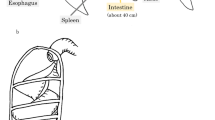Abstract
Purpose
Many disease processes (necrotizing enterocolitis, caustic esophageal injury, malrotation with volvulus), can result in short-gut syndrome (SGS), where remnant intestinal segments may dilate axially, but rarely elongate longitudinally. Here we mechanically characterize a novel model of a self-expanding mesh prototype intestinal expanding sleeve (IES) for use in SGS.
Methods
Gut lengthening was achieved using a proprietary cylindrical layered polyethylene terephthalate IES device with helicoid trusses with isometric ends. The IES is pre-contracted by diametric expansion, deployed into the gut and anchored with bioabsorbable sutures. IES expansion to its equilibrium dimension maintained longitudinal gut tension, which may permit remodeling, increased absorptive surface area while preserving vascular and nervous supplies. We performed mechanical testing to obtain the effective force–displacement characterization achieved on these prototypes and evaluated minimal numbers of sutures needed for its anchoring. Furthermore, we deployed these devices in small and large intestines of New Zealand White rabbits, measured IES length–tension relationships and measured post-implant gut expansion ex vivo. Histology of the gut before and after implantation was also evaluated.
Results
Longitudinal tension using IES did not result in suture failure. Maximum IES suture mechanical loading was tested using 4–6 sutures; we found similar failure loads of 2.95 ± 0.64, 4 ± 1.9 and 3.16 ± 0.24 Newtons for 4, 6 and 8 sutures, respectively (n = 3, n.s). Pre-contracted IES tubes were deployed at 67 ± 4% of initial length (i.l.); in the large bowel these expanded significantly to 81.5 ± 3.7% of i.l. (p = 0.014, n = 4). In the small bowel, pre-contracted IES were 61 ± 3.8% of i.l.; these expanded significantly to 82.7 ± 7.4% of i.l. (p = 0.0009, n = 6). This resulted in an immediate 24 ± 7.8% and 36.2 ± 11% increase in gut length when deployed in large and small bowels, respectively, with maintained longitudinal tension. Maintained IES induced tension produced gut wall thinning; gut histopathological evaluation is currently under evaluation.
Conclusion
IES is a versatile platform for gaining length in SGS, which may be simply deployed via feeding tubes. Our results need further validation for biocompatibility and mechanical characterization to optimize use in gut expansion.






Similar content being viewed by others
References
Sigalet DL (2001) Short bowel syndrome in infants and children: an overview. Semin Pediatr Surg 10:49–55
Demehri FR et al (2015) Enteral autonomy in pediatric short bowel syndrome: predictive factors one year after diagnosis. J Pediatr Surg 50:131–135
Bianchi A (1980) Intestinal loop lengthening–a technique for increasing small intestinal length. J Pediatr Surg 15:145–151
Kim HB et al (2003) Serial transverse enteroplasty (STEP): a novel bowel lengthening procedure. J Pediatr Surg 38:425–429
Greig CJ, Oh PS, Gross ER, Cowles RA (2019) Retracing our STEPs: Four decades of progress in intestinal lengthening procedures for short bowel syndrome. Am J Surg 217:772–782
Squires RH et al (2012) Natural history of pediatric intestinal failure: initial report from the Pediatric Intestinal Failure Consortium. J Pediatr. https://doi.org/10.1016/j.jpeds.2012.03.062
Spencer AU et al (2006) Enterogenesis in a clinically feasible model of mechanical small-bowel lengthening. Surgery 140:212–220
Safford SD, Freemerman AJ, Safford KM, Bentley R, Skinner MA (2005) Longitudinal mechanical tension induces growth in the small bowel of juvenile rats. Gut 54:1085–1090
Huynh N et al (2016) Spring-mediated distraction enterogenesis in-continuity. J Pediatr Surg. https://doi.org/10.1016/j.jpedsurg.2016.09.024
Demehri FR, Wong PM, Freeman JJ, Fukatsu Y, Teitelbaum DH (2014) A novel double-balloon catheter device for fully endoluminal intestinal lengthening. Pediatr Surg Int 30:1223–1229
Portelli KI et al (2021) Intestinal adaptation following spring insertion into a roux limb in mice. J Pediatr Surg 56:346–351
Dubrovsky G, Huynh N, Thomas AL, Shekherdimian S, Dunn JC (2019) Intestinal lengthening via multiple in-continuity springs. J Pediatr Surg. https://doi.org/10.1016/j.jpedsurg.2018.10.036
Ea M, Pi B, Dh T (2011) Redilation of bowel after intestinal lengthening procedures–an indicator for poor outcome. J Pediatr Surg 46:145–149
Gibbons TE, Casteel HB, Vaughan JF, Dassinger MS (2013) Staple line ulcers: a cause of chronic GI bleeding following STEP procedure. J Pediatr Surg. https://doi.org/10.1016/j.jpedsurg.2013.04
Sudan D et al (2007) Comparison of intestinal lengthening procedures for patients with short bowel syndrome. Ann Surg 246:593–601
Fallon EM et al (2014) Neonates with short bowel syndrome: an optimistic future for parenteral nutrition independence. JAMA Surg 149:663–670
Spencer AU et al (2005) Pediatric short bowel syndrome: redefining predictors of success. Ann Surg 242:403–412
Park J, Puapong DP, Wu BM, Atkinson JB, Dunn JC (2004) Enterogenesis by mechanical lengthening: morphology and function of the lengthened small intestine. J Pediatr Surg 39:1823–1827
Ralls MW et al (2013) Mesenteric neovascularization with distraction-induced intestinal growth: enterogenesis. Pediatr Surg Int 29:33–39
Okawada M, Maria HM, Teitelbaum DH (2011) Distraction induced enterogenesis: a unique mouse model using polyethylene glycol. J Surg Res 170:41–47
Stark R, Zupekan T, Bondada S, Dunn JCD (2011) Restoration of mechanically lengthened jejunum into intestinal continuity in rats. J Pediatr Surg 46:2321–2326
Author information
Authors and Affiliations
Corresponding author
Additional information
Publisher's Note
Springer Nature remains neutral with regard to jurisdictional claims in published maps and institutional affiliations.
Rights and permissions
About this article
Cite this article
Clayton, S., Alexander, J.S., Solitro, G. et al. Self-expanding intestinal expansion sleeves (IES) for short gut syndrome. Pediatr Surg Int 38, 75–81 (2022). https://doi.org/10.1007/s00383-021-05024-8
Accepted:
Published:
Issue Date:
DOI: https://doi.org/10.1007/s00383-021-05024-8




